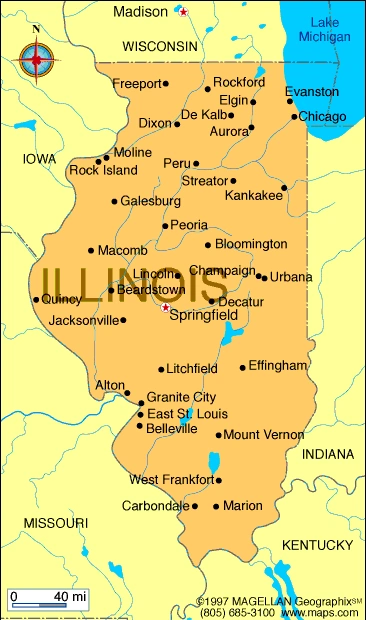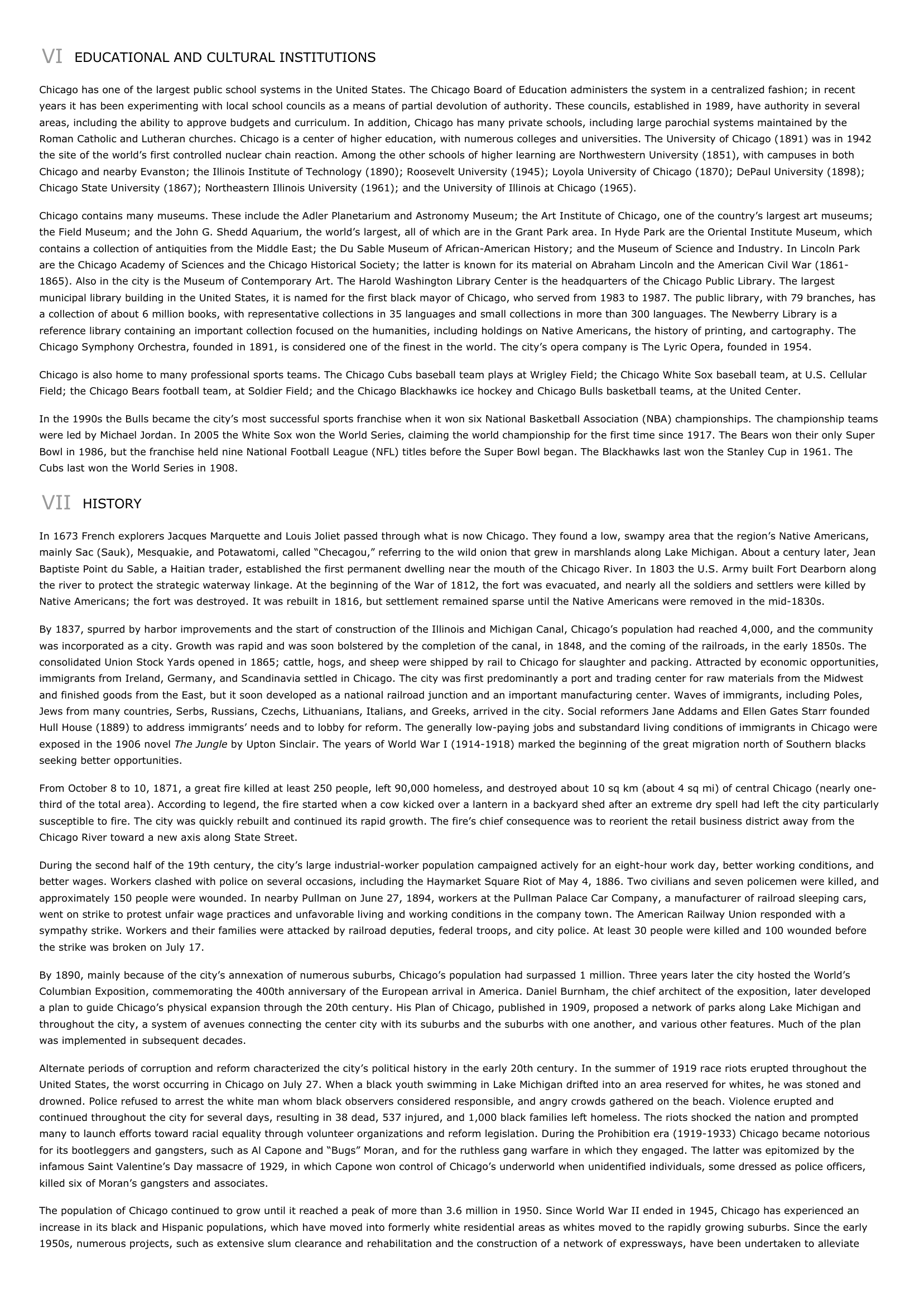Chicago (city, Illinois) - geography.
Publié le 04/05/2013
Extrait du document


«
VI EDUCATIONAL AND CULTURAL INSTITUTIONS
Chicago has one of the largest public school systems in the United States.
The Chicago Board of Education administers the system in a centralized fashion; in recentyears it has been experimenting with local school councils as a means of partial devolution of authority.
These councils, established in 1989, have authority in severalareas, including the ability to approve budgets and curriculum.
In addition, Chicago has many private schools, including large parochial systems maintained by theRoman Catholic and Lutheran churches.
Chicago is a center of higher education, with numerous colleges and universities.
The University of Chicago (1891) was in 1942the site of the world’s first controlled nuclear chain reaction.
Among the other schools of higher learning are Northwestern University (1851), with campuses in bothChicago and nearby Evanston; the Illinois Institute of Technology (1890); Roosevelt University (1945); Loyola University of Chicago (1870); DePaul University (1898);Chicago State University (1867); Northeastern Illinois University (1961); and the University of Illinois at Chicago (1965).
Chicago contains many museums.
These include the Adler Planetarium and Astronomy Museum; the Art Institute of Chicago, one of the country’s largest art museums;the Field Museum; and the John G.
Shedd Aquarium, the world’s largest, all of which are in the Grant Park area.
In Hyde Park are the Oriental Institute Museum, whichcontains a collection of antiquities from the Middle East; the Du Sable Museum of African-American History; and the Museum of Science and Industry.
In Lincoln Parkare the Chicago Academy of Sciences and the Chicago Historical Society; the latter is known for its material on Abraham Lincoln and the American Civil War (1861-1865).
Also in the city is the Museum of Contemporary Art.
The Harold Washington Library Center is the headquarters of the Chicago Public Library.
The largestmunicipal library building in the United States, it is named for the first black mayor of Chicago, who served from 1983 to 1987.
The public library, with 79 branches, hasa collection of about 6 million books, with representative collections in 35 languages and small collections in more than 300 languages.
The Newberry Library is areference library containing an important collection focused on the humanities, including holdings on Native Americans, the history of printing, and cartography.
TheChicago Symphony Orchestra, founded in 1891, is considered one of the finest in the world.
The city’s opera company is The Lyric Opera, founded in 1954.
Chicago is also home to many professional sports teams.
The Chicago Cubs baseball team plays at Wrigley Field; the Chicago White Sox baseball team, at U.S.
CellularField; the Chicago Bears football team, at Soldier Field; and the Chicago Blackhawks ice hockey and Chicago Bulls basketball teams, at the United Center.
In the 1990s the Bulls became the city’s most successful sports franchise when it won six National Basketball Association (NBA) championships.
The championship teamswere led by Michael Jordan.
In 2005 the White Sox won the World Series, claiming the world championship for the first time since 1917.
The Bears won their only SuperBowl in 1986, but the franchise held nine National Football League (NFL) titles before the Super Bowl began.
The Blackhawks last won the Stanley Cup in 1961.
TheCubs last won the World Series in 1908.
VII HISTORY
In 1673 French explorers Jacques Marquette and Louis Joliet passed through what is now Chicago.
They found a low, swampy area that the region’s Native Americans,mainly Sac (Sauk), Mesquakie, and Potawatomi, called “Checagou,” referring to the wild onion that grew in marshlands along Lake Michigan.
About a century later, JeanBaptiste Point du Sable, a Haitian trader, established the first permanent dwelling near the mouth of the Chicago River.
In 1803 the U.S.
Army built Fort Dearborn alongthe river to protect the strategic waterway linkage.
At the beginning of the War of 1812, the fort was evacuated, and nearly all the soldiers and settlers were killed byNative Americans; the fort was destroyed.
It was rebuilt in 1816, but settlement remained sparse until the Native Americans were removed in the mid-1830s.
By 1837, spurred by harbor improvements and the start of construction of the Illinois and Michigan Canal, Chicago’s population had reached 4,000, and the communitywas incorporated as a city.
Growth was rapid and was soon bolstered by the completion of the canal, in 1848, and the coming of the railroads, in the early 1850s.
Theconsolidated Union Stock Yards opened in 1865; cattle, hogs, and sheep were shipped by rail to Chicago for slaughter and packing.
Attracted by economic opportunities,immigrants from Ireland, Germany, and Scandinavia settled in Chicago.
The city was first predominantly a port and trading center for raw materials from the Midwestand finished goods from the East, but it soon developed as a national railroad junction and an important manufacturing center.
Waves of immigrants, including Poles,Jews from many countries, Serbs, Russians, Czechs, Lithuanians, Italians, and Greeks, arrived in the city.
Social reformers Jane Addams and Ellen Gates Starr foundedHull House (1889) to address immigrants’ needs and to lobby for reform.
The generally low-paying jobs and substandard living conditions of immigrants in Chicago wereexposed in the 1906 novel The Jungle by Upton Sinclair.
The years of World War I (1914-1918) marked the beginning of the great migration north of Southern blacks seeking better opportunities.
From October 8 to 10, 1871, a great fire killed at least 250 people, left 90,000 homeless, and destroyed about 10 sq km (about 4 sq mi) of central Chicago (nearly one-third of the total area).
According to legend, the fire started when a cow kicked over a lantern in a backyard shed after an extreme dry spell had left the city particularlysusceptible to fire.
The city was quickly rebuilt and continued its rapid growth.
The fire’s chief consequence was to reorient the retail business district away from theChicago River toward a new axis along State Street.
During the second half of the 19th century, the city’s large industrial-worker population campaigned actively for an eight-hour work day, better working conditions, andbetter wages.
Workers clashed with police on several occasions, including the Haymarket Square Riot of May 4, 1886.
Two civilians and seven policemen were killed, andapproximately 150 people were wounded.
In nearby Pullman on June 27, 1894, workers at the Pullman Palace Car Company, a manufacturer of railroad sleeping cars,went on strike to protest unfair wage practices and unfavorable living and working conditions in the company town.
The American Railway Union responded with asympathy strike.
Workers and their families were attacked by railroad deputies, federal troops, and city police.
At least 30 people were killed and 100 wounded beforethe strike was broken on July 17.
By 1890, mainly because of the city’s annexation of numerous suburbs, Chicago’s population had surpassed 1 million.
Three years later the city hosted the World’sColumbian Exposition, commemorating the 400th anniversary of the European arrival in America.
Daniel Burnham, the chief architect of the exposition, later developeda plan to guide Chicago’s physical expansion through the 20th century.
His Plan of Chicago, published in 1909, proposed a network of parks along Lake Michigan andthroughout the city, a system of avenues connecting the center city with its suburbs and the suburbs with one another, and various other features.
Much of the planwas implemented in subsequent decades.
Alternate periods of corruption and reform characterized the city’s political history in the early 20th century.
In the summer of 1919 race riots erupted throughout theUnited States, the worst occurring in Chicago on July 27.
When a black youth swimming in Lake Michigan drifted into an area reserved for whites, he was stoned anddrowned.
Police refused to arrest the white man whom black observers considered responsible, and angry crowds gathered on the beach.
Violence erupted andcontinued throughout the city for several days, resulting in 38 dead, 537 injured, and 1,000 black families left homeless.
The riots shocked the nation and promptedmany to launch efforts toward racial equality through volunteer organizations and reform legislation.
During the Prohibition era (1919-1933) Chicago became notoriousfor its bootleggers and gangsters, such as Al Capone and “Bugs” Moran, and for the ruthless gang warfare in which they engaged.
The latter was epitomized by theinfamous Saint Valentine’s Day massacre of 1929, in which Capone won control of Chicago’s underworld when unidentified individuals, some dressed as police officers,killed six of Moran’s gangsters and associates.
The population of Chicago continued to grow until it reached a peak of more than 3.6 million in 1950.
Since World War II ended in 1945, Chicago has experienced anincrease in its black and Hispanic populations, which have moved into formerly white residential areas as whites moved to the rapidly growing suburbs.
Since the early1950s, numerous projects, such as extensive slum clearance and rehabilitation and the construction of a network of expressways, have been undertaken to alleviate.
»
↓↓↓ APERÇU DU DOCUMENT ↓↓↓
Liens utiles
- Chicago (city, Illinois) - geography.
- Siegel ( Donald, dit Don), 1912-1991, né à Chicago (Illinois), cinéaste américain.
- Minnelli Vincente , 1910-1986, né à Chicago (Illinois), cinéaste américain.
- Ernest Hemingway Enfant de Chicago, Hemingway acheva sa scolarité en 1917, puis il partit à Kansas City où il trouva un emploi de reporter au Star.
- Konitz Lee , né en 1927 à Chicago (Illinois), saxophoniste alto américain.

































